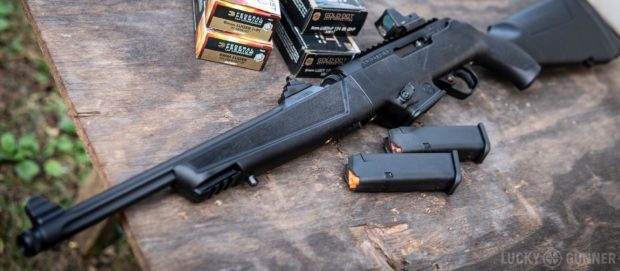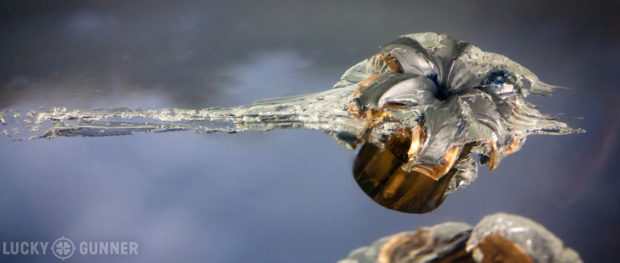Written by: Greg Ellifritz
I got a question from a friend and student last week. I think the answer will help all my readers better understand terminal ballistics and choose an optimal bullet for self protection. Here’s the question:
“Quick question: What’s your suggestion for 9mm carry ammo? I’m about to replace my near 10 year old Winchester ranger 127gr +p+. (Time just flies by) The federal HST seems more readily available. Looking at 124gr +p or 147gr +p for Glock 19 and 17. I may add a Glock 26 to the mix.”
There is a very simple answer to this question. Choose one of the loads on Dr. Gary Roberts’ list. All of those rounds passed the ballistic tests recommended by the FBI and exhibit good expansion and optimal penetration even after penetration of several different barrier types. Any of those rounds will perform admirably.
I would personally choose a round on the list that is readily available, reliable in your carry gun, and shoots to the gun’s sights. Having minimal recoil and a low-flash powder are also desirable characteristics.
As for my personal choice, I would choose either the Federal HST or Speer Gold Dot. Depending on the gun I am carrying, I would choose either the 124 grain or the 147 grain offering. These rounds consistently outperform all other bullet designs across multiple calibers. You really can’t go wrong with either of them. With that said, I think the HST performs slightly better than the Gold Dot. The HST is my choice of defensive ammunition in most handguns.
If my carry guns were all full sized, the 147 grain bullet is a better choice. In smaller guns the 147 grain slug occasionally fails to expand because of the short barrel’s reduced velocity. Bullets are designed to expand within a certain narrow band of possible velocities. Longer barrels allow more powder to be burnt before the bullet leaves the muzzle. That generally increases velocity. Faster velocities make the bullet expand more and penetrate less.
When you shoot a light for caliber bullet in a full sized gun, velocity tends to be higher than what the bullet designers anticipated for optimal expansion. Light bullets at high velocities expand more and penetrate less. You are more likely to get less than ideal penetration with a light bullet in a long barreled gun.
The converse is also true. Heavy bullets need greater velocities to expand. When those bullets are shot through very short barrels, they often don’t expand at all. With no energy being bled off in the expansion process, the heavier bullets at low velocities tend to over penetrate. For an illustration of this fact, read Self-Defense Ammo for Pistol Caliber Carbines.

Looking at the chart in the linked article, you can see how a longer barrel really increases velocity. That creates more expansion and less penetration.
If you are carrying a short barreled pistol like the S&W Shield, G43, G26, or Sig 365 you would be better served with the 124 grain bullet. The 124 grain will also work great out of full sized guns as well, but it penetrates less deeply than the 147 grain after shot out of a longer barrel.
Some of you might be confused about the +P or +P+ designation that the reader describes. If you don’t understand the concept, read +P Ammunition: What Higher-Pressure Ammo Means to You.
Assuming recoil control isn’t a real issue, I like the +P versions of the 9mm cartridges, especially in the smaller guns. That little extra bit of pressure helps keep the smaller guns from jamming as often. If you can shoot the +P (as contrasted from the standard velocity rounds) with roughly the same speed and accuracy as the standard loads, get the +P load if you are carrying in a short barreled defensive pistol.
If you want more information on the topic, do a search for “gelatin testing” on my website. I’ve highlighted a whole lot of public ballistic gelatin testing results with that description over the seven years I’ve been covering the issue on this blog.
Another excellent resource to study is Lucky Gunner’s handgun gelatin testing study. Almost every bullet you would be considering has been tested there. Keep in mind that the tests on that site were done with Clear Gelatin which is not exactly the same as the FBI calibrated ordnance gelatin. Penetration will be a little deeper in the clear gel and the bullets will expand a little less than in the original FBI tissue simulation.
Here’s the bottom line. In almost every caliber you’d carry for self defense, the Speer Gold Dot and the Federal HST top the lists of most effective bullets for stopping human aggression. Pick one of those and you will be OK. If those are unreliable or inaccurate in your guns, choose another round from Dr. Robert’s list.
There are many excellent bullet designs on the market right now. You have lots of potential options.


